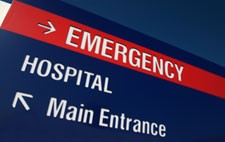| Medical errors in the U.S. kill up to 100,000 people every year. In its 1999 landmark book, To Err Is Human: Building a Safer Health System, the Institute of Medicine stated that medical errors in the U.S. kill up to 100,000 people every year. In other words, for every person killed in the U.S. by a drunk driver, two people are killed by medical errors. The number of people “injured” every year by medical errors is about half a million.
Whether you or a loved one is having a standard medical procedure or a medical emergency, the best way to stay safe is to advocate for yourself or your loved one. If you are uneasy about a procedure, a test, a diagnosis or a discharge – speak up, ask questions and stay informed. In an article for CoverMD, Dr. Barry Bialek highlights the top ten most common medical errors in the US (mainly attributed to hospitals): |
|
1. Technical medical error |
|
| “Billy’s stomach ache wasn’t getting any better. His mom was worried, but not enough to take him to the doctor. He was five years old and she figured it was something he ate. When Billy’s appendix burst, he was rushed to the local hospital. Everything would have been fine, if the surgeon, Dr. A, hadn’t inadvertently cut Billy’s renal artery. He bled to death on the operating table while his parents sat in the waiting room, praying for his recovery.” | |
2. Failure to use indicated tests |
|
| “Emily was cooking for her husband Jim’s 60th birthday party when her chest pain started. She assumed it was indigestion and didn’t want to disrupt their plans. But when it didn’t resolve, she told Jim, who drove her to a busy urgent care center. Dr. B failed to order an EKG and sent her home with a diagnosis of dyspepsia. Jim canceled the party until she was feeling better. Emily died the next day… from the heart attack that was causing her indigestion.” | |
3. Avoidable delay in treatment |
|
| “Michelle was in labor with her first baby. She and her husband, Mark, arrived at L&D, nervous and excited. They had done everything right during the pregnancy and were expecting a healthy baby. A pitocin drip was started and Michelle’s contractions began in earnest. Nurse C, the L&D nurse taking care of Michelle, watched for 45 minutes as Michelle’s contractions sped up and the baby’s heart rate dropped. Their baby son survived, but, because of his severe cerebral palsy, he needs round-the-clock care.” | |
4. Failure to take precautions |
|
| “Marvin was the classic out-of-shape, older American male. At 66, he’d suffered many “mini-strokes” and was unsteady on his feet. His 250 pounds didn’t help.. Nurse D, who helped him out of his bed to get to the bathroom, should have requested help herself. Marvin fell on top of Nurse D, breaking his hip and her wrist.” | |
5. Failure to act on test results |
|
| “Sara, usually a bright, energetic nine-year-old, was feeling sick. At the hospital, Dr. E ordered urine and blood tests, diagnosed a urinary tract infection, prescribed an oral antibiotic, and sent her home. When the blood tests came back an hour later, Dr. E didn’t look at them. Since her high blood sugar was never noted, it was never treated. Sara came back the next day in a diabetic coma. Though still alive, she’s never been the same and now struggles academically and emotionally.” | |
6. Inadequate monitoring after a procedure |
|
| “Tammy was 12 years old when she had her tonsils out at the ambulatory surgery center. In the recovery room, she appeared to be sleeping normally alongside the other patients. Nurse F didn’t notice that Tammy had stopped breathing, a side effect of the narcotics she had been given. Tammy never regained consciousness, but lives on, with the aid of 24-hour care.” | |
7. Inadequate patient preparation before a procedure |
|
| “Paul was going in for a simple procedure at the outpatient surgery center, but no one had notified him to stop taking his Coumadin, a blood thinner used to prevent clots from forming on his heart valve. When Dr. G cut a biopsy specimen from Paul’s bronchus, the bleeding wouldn’t stop, and it filled much of Paul’s right lung. Within two hours, Paul had bled to death.” | |
8. Inadequate follow-up after treatment |
|
| “Jasmine‘s bowels were in an uproar – and had been for fifteen years, ever since she was diagnosed with irritable bowel syndrome. Her new gastro-enterologist, Dr. H, wanted to do a colonoscopy and Jasmine agreed. The procedure went smoothly and Jasmine went home, sore, and somewhat intoxicated by the Versed she was given to relax. She had an extremely uncomfortable night and called the doctor on call, who suggested she wait until morning. In the morning she felt worse and slightly feverish. Dr. H also suggested she wait. Almost 48 hours after the procedure she called 911 and went to the hospital, where her colon leak was diagnosed. Three feet of her colon had to be cut out.” | |
9. Avoidable delay in diagnosis |
|
| “Sam was a 20-year-old college sophomore when he was assaulted at a local sports bar for rooting for the “wrong” team. He blacked out and woke up in the local emergency room, nauseous and with a bad headache. Dr. I decided to wait until morning for a head CT, rather than call in the CT team in the middle of the night. At 6 a.m., Sam’s continued intracranial bleeding raised the pressure inside his skull so much that he blacked out – forever.” | |
10. Improper medication dose and/or method of use |
|
| “Jessie loved chocolate cake — so much that even her diabetes couldn’t keep her away from it. During her best friend’s birthday celebration she had way too much and her blood sugar spiked dangerously high. Harry, her husband of 25 years, knew the routine – take her to the local ER. Dr. J made a number of critical errors—he gave too much insulin too quickly for too long. This starved Jessie’s brain of glucose and she died.” | |
May 4, 2015

Ten Most Common Medical Errors in The U.S.










